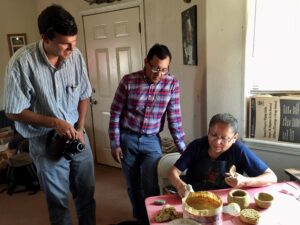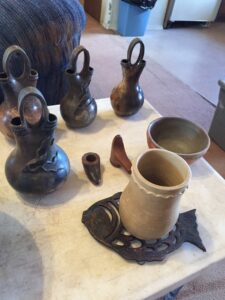Large chunks of the Navajo Nation in the Southwest lack access to clean drinkable water, a trend that has been rising in many parts of the U.S. in recent years. A research team led by engineers with The University of Texas at Austin is changing that.
The team has developed a new water filtration solution for members of the Navajo Nation, lining clay pots with pine tree resin collected from the Navajo Nation and incorporating tiny, silver-based particles that can be used to purify water to make it drinkable.
"Making water filtration technology cheap doesn't solve all the problems, and making it effective doesn't solve everything either," said Navid Saleh, a professor in the Fariborz Maseeh Department of Civil, Architectural and Environmental Engineering and one of the leaders on the project. "You have to think about the people you are making it for."
And that's what the researchers did. They worked closely with a third-generation potter from Arizona - Deanna Tso, who is also a co-author on the paper - to create a device that is simple for the users. All they have to do is pour water through the clay pots, and the coated pottery removes bacteria from water and generates clean, drinkable water.

The Navajo Nation has a history of mistrust of outsiders, the researchers say, and that makes it less likely that people there would adopt a new technology made entirely by others. Using pottery, working with the community, and relying on local materials were important to the effectiveness of this project.
The research appears in a new paper in the journal Environmental Science & Technology.
"Navajo pottery is at the heart of this innovation because we hoped it would bridge a trust gap," said Lewis Stetson Rowles III, now a faculty member at Georgia Southern University's Department of Civil Engineering and Construction after earning a Ph.D. from UT in 2021. "Pottery is sacred there, and using their materials and their techniques could help them get more comfortable with embracing new solutions."

Using silver particles for water filtration is not the main innovation. Others have used this technology in the past. The key is controlling the release of nanoparticles, which can reduce the usable life of the filters. And the silver particles mix at high volume with some of the chemicals, such as chloride and sulfide, in the untreated water, leading to a "poison layer" that can reduce the disinfection efficacy of the silver particles on the clay lining.
The researchers used materials abundant in the environment of the community, including pine tree resin, to mitigate the uncontrolled release of silver particles during the water purifying process. The materials and construction process for the pots cost less than $10, making for a potentially low-cost solution.
"This is just the beginning of trying to solve a local problem for a specific group of people," Saleh said. "But the technical breakthrough we've made can be used all over the world to help other communities."
The next step for the researchers is grow the technology and find other materials and techniques to help communities use the materials abundant in their regions to help create fresh, drinkable water. The researchers are not seeking to commercialize the research, but they are eager to share it with potential partners.
Other team members on the project include Desmond Lawler, a professor emeritus, who was Rowles' co-adviser; civil, architectural and environmental engineering professor Mary Jo Kirisits; and Andrei Dolocan, a senior research scientist at the Texas Materials Institute.






